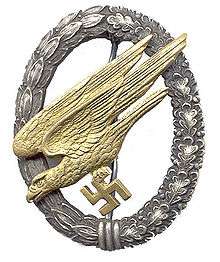Parachutist Badge (Germany)
| Fallschirmspringerabzeichen | |
|---|---|
|
Wehrmacht Luftwaffe Fallschirmschützenabzeichen | |
| Awarded by Nazi Germany | |
| Type | Military Badge |
| Eligibility | Soldiers of the German armed forces |
| Awarded for | Military Parachutist Proficiency |
| Status | Obsolete |
| Description | qualification badge |
| Statistics | |
| Established | 5 November 1936 |
The German Armed Forces Parachutist Badge (Fallschirmschützenabzeichen) was the badge awarded to and worn by qualified parachutists of the Armed Forces (Wehrmacht) of the Nazi Germany.
The Wehrmacht's Parachutist Badge was first established by order of Hermann Göring on 5 November 1936.[1] It was originally awarded to soldiers of the Luftwaffe after completion of parachute training and the required number of six jumps. The badge depicted a diving eagle with a swastika in its claws surrounded by a silver wreath. The original construction was made of "gold-finished bronze" for the eagle and "oxidized silver plate" for the laurel leaves. In 1937, the construction of the badge changed to aluminum. In late 1942, the construction was changed again to metal alloy. A cloth version of the badge was also authorized in 1937, to be worn on a flight jacket. The badge was worn over the left breast pocket.[2] A recipient had to re-qualify for the badge each year.[3]
An army version (Fallschirmschützen-Abzeichen des Heeres) was later introduced (1 September 1937), with the swastika relocated to the top of the wreath and surmounted by a smaller upright eagle.[4] As with the Luftwaffe, a recipient had to re-qualify for the badge each year.[5]
On 4 October 1936 the army ordered the institution of its own parachute company, a Fallschirm-Infanterie-Kompanie. The army did not have a training facility of its own, thus they utilized the already established Luftwaffe facility at Stendal/Borstel (under Olt. Bassange) exclusively.
On 1 June 1938, the Fallschirm-Infanterie-Kompanie was officially expanded (per order HM38 No.286 dated 15 March 1938) to the Fallschim-Infanterie-Batallion. In addition to the Nachrichten-Zug and the Pionier-Zug, there were 4 infantry companies, the 4th being "heavy" (machine guns and mortars), under Major Heidrich and Capt. Prager. 1st Company (under Olt. von Brandis), 2nd Company (under Olt. Huebner), 3rd Company (under Lt. Pagels) and 4th Company (under Olt. Peltz). On 4 November 1938, the Fallschirm-Infanterie-Batallion moved from Stendal to their new barracks (the Rosalies Kaserne) in Braunschweig. When the army parachute units were transferred over to the Luftwaffe in 1939, the former army soldiers continued to wear the army version of the Parachutist badge.[6]
For the Waffen-SS soldiers of the 500, 501 or 502 SS-Parachute Battalions, they were awarded the Luftwaffe badge after they passed the jump and other test requirements.[7] The Army Paratroopers Badge was re-instituted on 1 June 1943 with the formation of the 15th (Fallschirmjager-) Kompanie of Brandenburg Regiment 4 (on 1 April 1943).
Notes
- ↑ Angolia 1987, p. 193.
- ↑ Angolia 1987, pp. 193, 194, 196.
- ↑ Angolia 1987, p. 194.
- ↑ Angolia 1987, pp. 78, 79.
- ↑ Angolia 1987, p. 78.
- ↑ Angolia 1987, pp. 78, 194.
- ↑ Angolia 1987, p. 195.
References
- Angolia, John (1987). For Führer and Fatherland: Military Awards of the Third Reich. R. James Bender Publishing. ISBN 0912138149.
